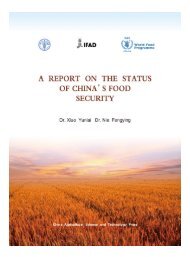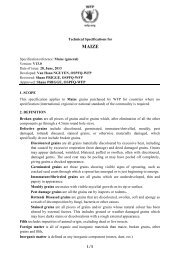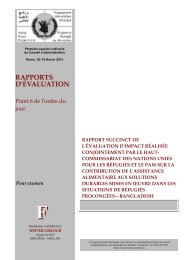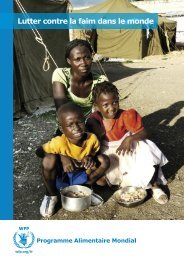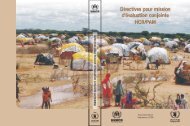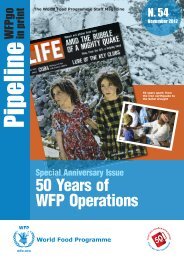High Food Price Impact Assessment and Analysis - WFP Remote ...
High Food Price Impact Assessment and Analysis - WFP Remote ...
High Food Price Impact Assessment and Analysis - WFP Remote ...
Create successful ePaper yourself
Turn your PDF publications into a flip-book with our unique Google optimized e-Paper software.
- Getting a rigorous answer to the impact of prices without a comprehensive set of new information is difficult.<br />
- Building scenarios to capture the future impacts of prices on household food security is difficult, given the<br />
increased volatility of prices.<br />
• Identifying a minimum set of information to meet information needs under different settings proved to be of high<br />
interest for the workshop participants. Two working groups addressed this issue, involving a third of<br />
participants. However, the working groups found it difficult <strong>and</strong> challenging to identify a minimum set<br />
of information. A tiered approach was therefore recommended (see section 4, key issue #2 for details).<br />
• The agenda was adjusted. Instead of discussing a pre-identified topic such as the third sub-objective, i.e. strengthen<br />
the interface between assessment findings <strong>and</strong> programming responses, the approach of defining important issues based on<br />
presentations was largely adopted by participants. As a result, the 2.5 day discussions produced the following<br />
outputs:<br />
- Identification of 28 issues emerging from recent experience <strong>and</strong> current work related to the collection,<br />
analysis <strong>and</strong> use of information in the current context.<br />
- Identification of 9 Key issues from among this set of 28: 4 issues identified on day 1 <strong>and</strong> 5 issues on day 2.<br />
- A description of the current situation with regard to each of these 9 key issues.<br />
- A set of recommendations as to how each of these 9 key issues should be addressed.<br />
- A list of current activities, by agency, where these recommendations can be put to use, <strong>and</strong> where<br />
collaboration between agencies may be possible.<br />
The details of these outputs are presented in the rest of the report.<br />
2.3 Process of the workshop<br />
On day 1, the presentations focussed on the use of existing monitoring systems <strong>and</strong> secondary<br />
information sets in addressing the food price crisis. Day-2 presentations focussed on assessments based<br />
mainly on primary data collection <strong>and</strong> analysis to inform on the impacts of the food price crisis on<br />
households’ food security. Day-3 focussed on the prioritisation of issues <strong>and</strong> recommendations <strong>and</strong> the<br />
way forward.<br />
The following process guided the workshop:<br />
• Overview – setting the context<br />
• Inputs – presentations on ongoing work, highlighting successes, challenges, <strong>and</strong> what is being learnt<br />
• Identification of common themes <strong>and</strong> challenges emerging from the presentations<br />
• Identification of key issues from among these common themes <strong>and</strong> challenges<br />
• Establishing recommendations as to how these key issues might be addressed.<br />
• Prioritisation <strong>and</strong> re-grouping of issues <strong>and</strong> recommendations<br />
• Identification of programmes where recommendations can be integrated <strong>and</strong> tested<br />
• Plans for sharing information between programmes on the results of integrating recommendations.<br />
3 Overview – Setting the Context<br />
3.1 Introduction <strong>and</strong> relevance for programming<br />
(by Valerie Guarnieri, Director <strong>WFP</strong> Progamme Design <strong>and</strong> Support Division - OMX)<br />
• <strong>High</strong> food prices are exacerbating structural <strong>and</strong> acute vulnerability, leading to i) a deterioration of<br />
the situation of people who already receive <strong>WFP</strong>’s assistance, ii) an increase in the number of<br />
people at risk of food insecurity, iii) a real challenge for <strong>WFP</strong>’s responses as costs are increasing<br />
<strong>and</strong> less food is available on the markets, iv) governments’ policy measures that may not be<br />
sufficient to mitigate the impacts of price rises.<br />
4









